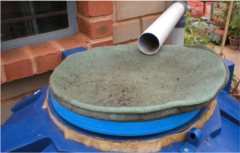A team of women slum dwellers of were recently at the Rainwater Club of Bangalore. The Rainwater Club is an organization that has been disseminating information on rainwater harvesting, run by S.Vishwanath, a water activist of international repute. Vishwanath was showing the women a small plastic drum that collects rainwater. "Ishtena? Ishtena?" (Is it this simple, this simple?), a woman was exclaiming often.

![]() A rain barrel connected to the roof through a PVC pipe. Pic: S Vishwanath
A rain barrel connected to the roof through a PVC pipe. Pic: S Vishwanath
Another occasion involved a gram panchayat member from Anekal. He was so moved that then and there he took a decision to build a 10,000 litre Rainwater Storage tank in his village.
The system that prompted the slum women and Gram Panchayat member is called a 'rain barrel'. Says Vishwanath, "It is a simple way for people to start harvesting rainwater".
Generally, people are not aware of the quantity of rainwater that pours on their house-site or campus. Also, most of them are not psychologically prepared to accept rain water as potable water. "It is this entry barrier that is most difficult to break", opines Vishwanath. It is here that the rain barrel comes in handy to melt away the mental block. One can describe rain barrel as a catalyst for rainwater harvesting.
The rain barrel is an ordinary plastic rainwater storage drum available anywhere. The catchment area (roof or terrace) has to be cleaned once during the beginning of the monsoon. The rain that falls on the roof, by gravitational pull, reaches the drum through the PVC down pipe. For convenience, the rain barrel is placed on a platform 18 inches above the ground. The platform facilitates drawl of water from a bucket or a hosepipe. The bottom of the drum has a tap.
A gate valve is fitted at the end of the downpipe and this is to allow the water from the first rains of the season to run out. After 2-3 rains, you can close the valve. Once closed, the rainwater flows into your barrel. On the top of the drum is a filter to improve the quality of the collected rainwater. This is a small-perforated aluminum/stainless steel basin with two layers of sponge on it. How thick the sponge should be? "Oh! Dont worry much on this. If sponge is not easy available", assures Vishwanath, you can place a three-fold layer of ordinary dhoti.
The sponge filter is visible from outside, so when it is visibly clogged, it is time to clean it. Cleaning is easily done by washing the sponge in a bucket of water. Cleaning 3 or 4 times in a year may be enough. There is no need to replace the sponge sheet.

![]() The rain barrel's filter is sponge. Pic: S Vishwanath
The rain barrel's filter is sponge. Pic: S Vishwanath
A rain barrel can collect a substantial amount of water, given it is emptied every time it rains. Assuming that the citizen empties the barrel once everyday (during the rainy season), a 50 sq.m space on the roof connected to a 500 litre rain barrel can collect nearly 23,000 litres of rainwater in a year, under Bangalore conditions. Similarly a 1000 litre rain barrel can collect nearly 35,000 litres of water in a year. In many parts of Kerala with over 100 days of rain annually, a 500 litre can collect around 40,000 litres!
The space required for a rain barrel itself is four cubic feet. On average, installing a rain barrel of 500 litres should cost about Rs 2500. A 1000 litre rain barrel would cost approximately Rs 4300.
Every rain barrel has a tap and an overflow outlet. The water collected in the rain barrel can be used to recharge open wells or bore wells. Using a hosepipe and a Zero-B type filter, the tap can be connected to the bore well or sump tank for domestic usage. A Zero-B filter costs about Rs 60. Overflows from rain barrels can also be used for recharging the ground.
• Rain water harvesting, book
• Sari for water harvesting
The Rainwater Club is using a small rain barrel since many years. "We have kept it on our first floor for many uses including drinking, cooking, Vishwanath points out, and also for our terrace garden."
Rain barrels are beginning to be accepted among industries and residences in Bangalore. WeP Peripherals in Mysore has installed 6 rain barrels of 1000 litres each. ITC (Indian Tobacco) has about 4. Total number of rain barrels in Bangalore would be around 50 at present.
For those who are not very much convinced about the quality and quantity of rain one can harvest, Vishwanath suggests they go in for a rain barrel and decide the next step based on a sample experience. "It lets you to get a feel of quantity of water one can collect from his roof, its cleanliness & safety and all the benefits". For big industries, offices etc, rain barrel is like a sample package of rain harvesting.
What's more, a rain barrel can be fitted in one day. But are there any agencies that install rain barrels? "As of now, there are none. But this is very simple. With a little training any plumber can install one", Vishwanath replies. Keeping this objective in mind, the Rainwater Club held a one-day training for interested plumbers at Bangalore in July last year.

![]() S.Vishwanath of Bangalore's Rainwater Club. Pic: S Vishwanath
S.Vishwanath of Bangalore's Rainwater Club. Pic: S Vishwanath
Rain barrels have an important role in taking harvesting to the grass-roots. If all our corporate and industrial houses, MLA's offices, zilla panchayat, panchayat, district collector's and other government offices, etc., install rain barrels, drink water from it and offer it to visitors with a word of praise, this can break what Vishwanath calls the "entry barrier".
